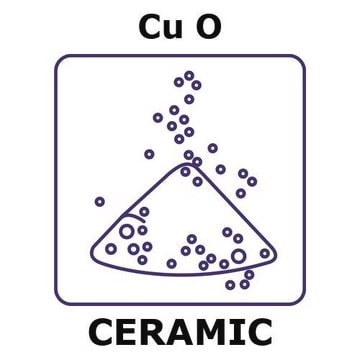1.02765
Copper oxide
wire fine about 0.65 x 3 mm for elementary analysis (surface: CuO, core: Cu₂O) ACS
Synonim(y):
Copper oxide
About This Item
Polecane produkty
klasa czystości
ACS reagent
Poziom jakości
Próba
(oxygen demand as CuO): -≥ 55.0 %
Postać
solid
masa
=79.54 g/mol
mp
1300 °C
gęstość
6.2 g/cm3 at 20 °C
gęstość nasypowa
2200 kg/m3
ślady kationów
C: ≤0.002%
N: ≤0.002%
temp. przechowywania
2-30°C
ciąg SMILES
O=[Cu]
InChI
1S/Cu.O
Klucz InChI
QPLDLSVMHZLSFG-UHFFFAOYSA-N
Zastosowanie
- A study on a broadband photodetector based on hybrid 2D copper oxide/reduced graphene oxide.: This research developed a photodetector utilizing a novel hybrid of copper oxide and reduced graphene oxide, demonstrating enhanced broadband detection capabilities, which is significant for advancements in optical sensing technologies (Ngo et al., 2024).
- Electro-sensing layer constructed of a WO(3)/CuO nanocomposite, for the electrochemical determination of 2-phenylphenol fungicide.: The paper discusses the fabrication and application of a tungsten oxide/copper oxide nanocomposite layer for sensitive and selective electrochemical detection of the fungicide 2-phenylphenol, highlighting its potential in environmental monitoring (Prabhu et al., 2023).
- Copper Oxide Solution Sensor Formed on a Thin Film Having Nanowires for Detecting Ethanol in Water.: This study presents the development of a copper oxide-based sensor with nanowire-enhanced thin films for detecting ethanol in water, offering a promising approach for environmental and health-related applications (Kimura and Tohmyoh, 2022).
- Tuning the Redox Chemistry of Copper Oxide Nanoarchitectures Integrated with rGOP via Facet Engineering: Sensing H(2)S toward SRB Detection.: This article explores the facet-engineered modification of copper oxide nanostructures combined with reduced graphene oxide, improving their redox properties for hydrogen sulfide sensing, which is crucial in detecting sulfate-reducing bacteria in industrial applications (Asif et al., 2022).
Komentarz do analizy
Chloride (Cl): ≤ 0.005 %
Total carbon (C): ≤ 0.002 %
Total nitrogen (N): ≤ 0.002 %
Total sulfur (as SO₄): ≤ 0.005 %
Hasło ostrzegawcze
Warning
Zwroty wskazujące rodzaj zagrożenia
Zwroty wskazujące środki ostrożności
Klasyfikacja zagrożeń
Aquatic Acute 1 - Aquatic Chronic 1
Kod klasy składowania
11 - Combustible Solids
Klasa zagrożenia wodnego (WGK)
WGK 3
Temperatura zapłonu (°F)
Not applicable
Temperatura zapłonu (°C)
Not applicable
Certyfikaty analizy (CoA)
Poszukaj Certyfikaty analizy (CoA), wpisując numer partii/serii produktów. Numery serii i partii można znaleźć na etykiecie produktu po słowach „seria” lub „partia”.
Masz już ten produkt?
Dokumenty związane z niedawno zakupionymi produktami zostały zamieszczone w Bibliotece dokumentów.
Nasz zespół naukowców ma doświadczenie we wszystkich obszarach badań, w tym w naukach przyrodniczych, materiałoznawstwie, syntezie chemicznej, chromatografii, analityce i wielu innych dziedzinach.
Skontaktuj się z zespołem ds. pomocy technicznej




